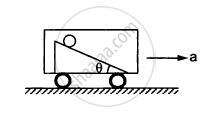Advertisements
Advertisements
प्रश्न
Read each statement below carefully, and state, with reasons, if it is true or false;
A wheel moving down a perfectly frictionless inclined plane will undergo slipping (not rolling) motion
उत्तर
True
The rolling of a body occurs when a frictional force acts between the body and the surface. This frictional force provides the torque necessary for rolling. In the absence of a frictional force, the body slips from the inclined plane under the effect of its own weight.
APPEARS IN
संबंधित प्रश्न
If a rigid body of radius ‘R’ starts from rest and rolls down an inclined plane of inclination
‘θ’ then linear acceleration of body rolling down the plane is _______.
A stone of mass 2 kg is whirled in a horizontal circle attached at the end of 1.5m long string. If the string makes an angle of 30° with vertical, compute its period. (g = 9.8 m/s2)
A sphere can roll on a surface inclined at an angle θ if the friction coefficient is more than \[\frac{2}{7}g \tan\theta.\] Suppose the friction coefficient is \[\frac{1}{7}g\ tan\theta.\] If a sphere is released from rest on the incline, _____________ .
The following figure shows a smooth inclined plane fixed in a car accelerating on a horizontal road. The angle of incline θ is related to the acceleration a of the car as a = g tanθ. If the sphere is set in pure rolling on the incline, _____________.

Discuss the interlink between translational, rotational and total kinetic energies of a rigid object rolls without slipping.
What is the condition for pure rolling?
A man is supported on a frictionless horizontal surface. It is attached to a string and rotates about a fixed centre at an angular velocity `omega`. The tension in the strings is F. If the length of string and angular velocity are doubled, the tension in string is now ____________.
The power (P) is supplied to rotating body having moment of inertia 'I' and angular acceleration 'α'. Its instantaneous angular velocity is ______.
A solid spherical ball rolls on an inclined plane without slipping. The ratio of rotational energy and total energy is ______.
The kinetic energy and angular momentum of a body rotating with constant angular velocity are E and L. What does `(2E)/L` represent?
